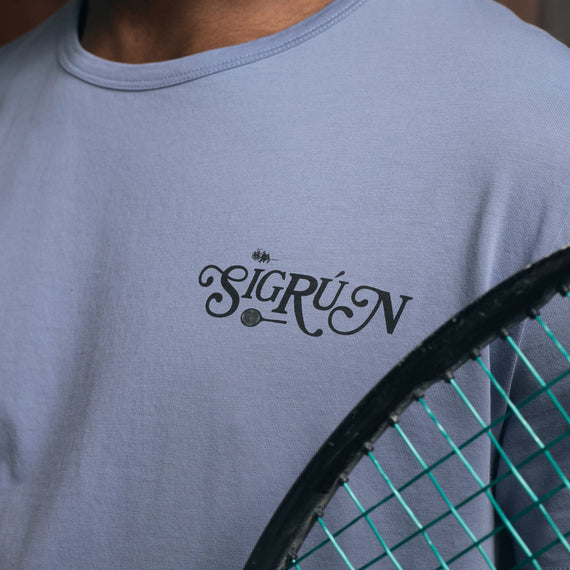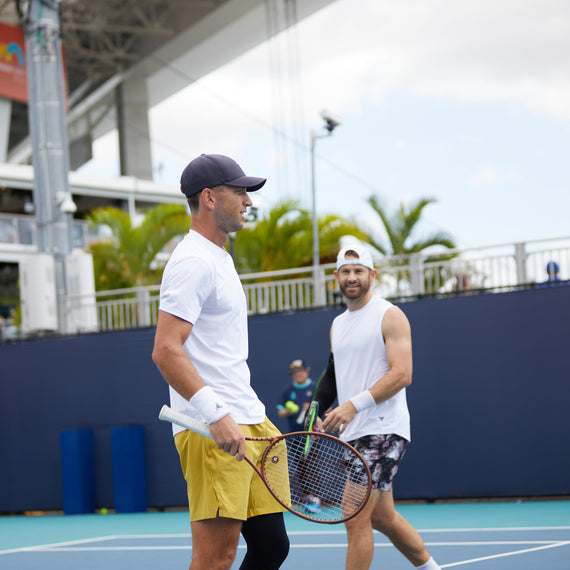Warm-up routines to maximize your performance
Warm-up is misunderstood by tennis players at all levels. It’s much more than getting loose. It’s a time to align habits, clear your mind, and maximize performance.
That’s why pros and college teams take warmup so seriously. And there’s a lot you can learn from them.
The best part is a good warmup doesn’t have to be involved. Just considering it in a more structured way can give you a huge advantage - whether USTA national player or Sunday morning all-star.
As a top 100 junior, division 1, and ITF tour player, knowledge I’ve gained from college coaches, pro athletes, and peers has been invaluable in the way I prepare for matches and permanently raised my level. Below is a collection of those key points that I hope will do the same for you.
The Parts
There are three parts to warmup.
- Physical
- Technical
- Mental
Physical Warmup
In case it hasn’t reached all corners of the tennis world – static stretching (toe touching, butterfly) doesn’t warm you up.
Active movements, waking up the muscles “in order,” will maximize your body’s output. Starting from small muscles, small movements working up to big muscles big movements.
For example, start with:
- Resistance bands (for shoulders, wrists, etc.)
- Wrist and ankle mobility
- Shoulder stretches
Here’s a quick guide to resistance bands for those who are unfamiliar.
Then move to bigger movements:
- Hip swings
- Jogging, shuffling, crossovers
- Dynamic movements you’ve likely heard: High knees, butt kicks, monster walks, etc.
Then to explosive movements:
- Jumps
- Sprints
- High speed ladder/footwork drills.
Here is an example of a division 1 college team, Western Michigan University’s physical warmup:
- 3 Minutes of resistance band work
- 3 laps around 4 courts, jogging, shuffling, crossover, backpedaling
- Dynamics:
- High knees
- Butt kicks
- Lunge with twist
- Reverse and side lunge
- High kicks
- Walking toe touches
- More as needed
- Finish with multiple 1 court suicide sprint
And for those of you with less space and time, here’s a warmup workout easily doable on your own, with all exercises done in place.

Physical warmup is important but these next phases, the overlooked ones, will really separate you.
Technical Skill Warmup
On match day we tend to get into result-oriented thinking – I hope I play well – really quickly. But like the physical warmup, there is an order to prepping your skills and habits for use in competition.
The key is to “build” your stroke from the ground up, one piece at a time, focusing on correct habits. Give yourself permission to miss in service of correct habits. And slowly address each element of your stroke one by one, no matter how trivial it seems. The process looks something like:
Touch games
- Start volley to volley or little mini games right on top of the net. These narrow hand-eye focus and allow you to feel the ball on the sweet spot. That is after all the basic function of a tennis – contacting the ball on the right part of the strings. So prioritize that before all else.
Mini tennis
- Building on the above step. Rallying from the service line, but not just casually. Small, slow swings with emphasis on sweet spot contact and proper form.
Habit focus
- Before picking up speed, think about your strokes. Every player has touch points to their strokes that get them going. Think about those now. Exaggerate correct habits. Don’t just do things right, be excessive about them. Instead of worrying about hitting good shots, worry about checking all the boxes for the things that make your stroke stick.
- For example, one things pros will do is elongate swings, swinging extra slow and long. Making sure to maintain focus on clean contact. Then “holding” their finish for an extra beat. Pausing like this makes you consider each stroke, not gloss over flaws.
- Take this video (just the first 2 minutes) of Dominic Thiem warming up hours before his match. Note several things:
- On his forehand, he “catches” his follow through with his left hand. This is not his “real” follow through. He won’t do it in match. It’s a warmup tactic to hold his finish and control his habits.
- The racket speed. And ball speed. Both slow. And Thiem is the biggest ball striker in the world. This 20-30% speed persists for 5-10 minutes before he’s comfortable enough to increase.
- His lack of footwork. It’s not time to move yet – despite what most coaches would have you believe. He’s not being lazy. He’s choosing specifically not to move or reach for difficult shots until he lines up his feel, hand-eye, and technique. Then he’ll build in more complicated aspects as he progresses.
Let loose
- When you’ve carefully moved through each element of your stroke, you speed up. Go through cross courts, volleys, etc. After setting technique correctly, slowly pick up speed until you allow yourself to drift into autopilot – forgetting about technique entirely for the rest of the match.
Technical warmup:
- Start small and find the sweet spot
- Move to slow, deliberate swings
- Exaggerate correct habits, hold the finish, to set technique.
- Build speed until entering autopilot mode
Mental Warmup
Mental warmup is about foregoing “I hope I feel good,” in favor of always feeling the same. And it can start before you even take the court.
Visualize
One thing every great athlete does is visualize their match. Visualizing the thing you’re striving for has a proven positive effect on performance. So, if you can, even the night before, on the drive over, or before you step on the court, visualize yourself playing perfect points, the way you want to in a match. It’s a great place to start.
Focus on what you can control
We allow factors – what if I miss? What if I play badly? – to add to our stress. We think about them without even realizing. And we forget that they’re not totally in our control. To loosen yourself up during warmup, hyper focus on the small things you have 100 percent control over (hint: making the shot is not one).
- Habits
- How you think
- Strategies
- Intentions
- And more
Even how hard you squeeze the grip, how you breathe. Essentially, there should be a judgement free period during warmup where you don’t worry about results, only about doing the things you can 100 percent control to the best of your ability. Give yourself little wins that you and only you control.
Emphasize the positive
When a shot feels good, acknowledge it. physically say: good, that one. Dwell in that moment. Meanwhile, if you mess up, throw it out. Your brain doesn’t distinguish between positive and negative. It only knows focus on this thing. That’s why someone yelling don’t miss works. Your brain focuses on miss.
So focus on the right stuff in warm-up. The good stuff. Dwell in the good, toss out the bad. This both makes you feel good and gets your brain working the way you need it to in match.
Make a pact
Come to terms with “going down swinging.” And what that means for you. What are your strengths, weaknesses, what do you do when you play well? As you hit say the full sentence in your head. “I will do XXXX, no matter what. And if I lose doing XXXX that’s okay.” Letting go control over the outcome is huge in getting mentally prepared.
Prepare a mantra
The last step is to condense everything into bite size form. You’ve got a lot to think about but you need your brain free and clear. So prepare a mantra that you can state in a single breath, and lean on, that is representative of everything you want to do. Think of it like putting your preparation into a labeled folder. And reading the label only.
“Swing away.”
“Rip the forehand.”
“Loose hands.”
“Be aggressive.”
“Have fun.”
Pick something that clicks for you. And as you prepare to play, repeat it to yourself. Throughout the match in times of stress, instead of opening your mind to everything else – just repeat the mantra.
Here are some examples of great athletes’ mantras:
- Russell Wilson: Why not you?
- Marlen Esparza (professional boxer): I deserve to win.
- Phil Jackson: Create conditions for success. Let go of outcome.
- Bill Rogers (4-time Boston Marathon winner): Relentless.
They’re short, positive, and mean nothing to you. But to the people who prepared them, they encapsulate everything they’ve been working towards.
Mental warmup:
- Focus what you can control
- Emphasize the positive
- Make a pact
- Repeat your mantra
Conclusion
There are many more elements great players incorporate in their warmup – meditation, jogging, zoning in, zoning out, etc. World champion speed skater Apolo Ohno would yawn intentionally all throughout his warmup.
Warmup is an involved process that tennis players take for granted. But proper warmup, especially mental, can provide a distinct competitive advantage. So experiment, fail, find what works. Because slight improvements to your warmup structure will put you miles ahead of your competitors.








